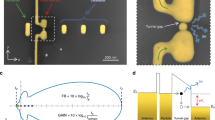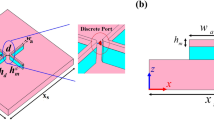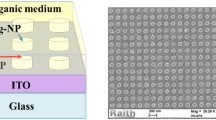Abstract
The plasmon resonance of metal nanoparticles can direct light from optical emitters in much the same way that radiofrequency antennas direct the emission from electrical circuits. Recently, rapid progress has been made in the realization of single-element antennas for optical waves1,2,3,4,5,6,7,8,9,10,11,12. Because most of these devices are designed to optimize the local near-field coupling between the antenna and an emitter, the possibility of modifying the spatial radiation pattern has not yet received as much attention13,14. In the radiofrequency regime, a typical antenna design for high directivity is the Yagi–Uda antenna, which essentially consists of a one-dimensional array of antenna elements driven by a single feed element. By fabricating a corresponding array of nanoparticles, similar radiation patterns can be obtained in the optical regime15,16,17,18. Here, we present the experimental demonstration of directional control of radiation from a nano-optical Yagi–Uda antenna composed of appropriately tuned gold nanorods.
This is a preview of subscription content, access via your institution
Access options
Subscribe to this journal
Receive 12 print issues and online access
$209.00 per year
only $17.42 per issue
Buy this article
- Purchase on Springer Link
- Instant access to full article PDF
Prices may be subject to local taxes which are calculated during checkout




Similar content being viewed by others
References
Crozier, K. B., Sundaramurthy, A., Kino, G. S. & Quate, C. F. Optical antennas: resonators for local field enhancement. J. Appl. Phys. 94, 4632–4642 (2003).
Fromm, D. P., Sundaramurthy, A., Schuck, P. J., Kino, G. & Moerner, W. E. Gap-dependent optical coupling of single ‘bowtie’ nanoantennas resonant in the visible. Nano Lett. 4, 957–961 (2004).
Schuck, P. J., Fromm, D. P., Sundaramurthy, A., Kino, G. S. & Moerner, W. E. Improving the mismatch between light and nanoscale objects with gold bowtie nanoantennas. Phys. Rev. Lett. 94, 017402 (2005).
Mühlschlegel, P., Eisler, H.-J., Martin, O. J. F., Hecht, B. & Pohl, D. W. Resonant optical antennas. Science 308, 1607–1609 (2005).
Aizpurua, J. et al. Optical properties of coupled metallic nanorods for field-enhanced spectroscopy. Phys. Rev. B 71, 235420 (2005).
Farahani, J. N., Pohl, D. W., Eisler, H.-J. & Hecht, B. Single quantum dot coupled to a scanning optical antenna: a tunable superemitter. Phys. Rev. Lett. 95, 017402 (2005).
Kühn, S., Håkanson, U., Rogobete, L. & Sandoghdar, V. Enhancement of single-molecule fluorescence using a gold nanoparticle as an optical nanoantenna. Phys. Rev. Lett. 97, 017402 (2006).
Sundaramurthy, A. et al. Toward nanometer-scale optical photolithography: utilizing the near-field of bowtie optical nanoantennas. Nano Lett. 6, 355–360 (2006).
Fromm, D. P. et al. Exploring the chemical enhancement for surface-enhanced Raman scattering with Au bowtie nanoantennas. J. Chem. Phys. 124, 061101 (2006).
Muskens, O. L., Giannini, V., Sánchez-Gil, J. A. & Rivas, J. G. Strong enhancement of the radiative decay rate of emitters by single plasmonic nanoantennas. Nano Lett. 7, 2871–2875 (2007).
Bakker, R. M. et al. Enhanced localized fluorescence in plasmonic nanoantennae. Appl. Phys. Lett. 92, 043101 (2008).
Bakker, R. M. et al. Nanoantenna array-induced fluorescence enhancement and reduced lifetimes. New J. Phys. 10, 125022 (2008).
Taminiau, T. H., Moerland, R. J., Segerink, F. B., Kuipers, L. & van Hulst, N. F. λ/4 Resonance of an optical monopole antenna probed by single molecule fluorescence. Nano Lett. 7, 28–33 (2007).
Taminiau, T. H. et al. Optical antennas direct single-molecule emission. Nature Photon. 2, 234–237 (2008).
Li, J., Salandrino, A. & Engheta, N. Shaping light beams in the nanometer scale: A Yagi–Uda nanoantenna in the optical domain. Phys. Rev. B 76, 245403 (2007).
Hofmann, H. F., Kosako, T. & Kadoya, Y. Design parameters for a nano-optical Yagi–Uda antenna. New J. Phys. 9, 217 (2007).
Pellegrini, G., Mattei, G., Mazzoldi, P. Tunable, directional and wavelength selective plasmonic nanoantenna arrays. Nanotechnology, 20, 065201 (2009).
Koenderink, A. F. Plasmon nanoparticle array waveguides for single photon and single plasmon sources. Nano Lett. 9, 4228–4233 (2009).
Purcell, E. M. Spontaneous emission probabilities at radio frequencies. Phys. Rev. 69, 681 (1946).
Hulet, R. G., Hilfer, E. S. & Kleppner, D. Inhibited spontaneous emission by a Rydberg atom. Phys. Rev. Lett. 55, 2137–2140 (1985).
Björk, G., Machida, S., Yamamoto, Y. & Igeta, K. Modification of spontaneous emission rate in planar dielectric microcavity structures. Phys. Rev. A 44, 669–681 (1991).
Ogawa, S., Imada, M., Yoshimoto, S., Okano, M. & Noda, S. Control of light emission by 3D photonic crystals. Science 305, 227–229 (2004).
Balanis, C. A. Antenna Theory Analysys and Design 3rd edn, 577 (John Wiley & Sons, 2005).
Craig, F. B. & Donald, R. H. Absorption and Scattering of Light by Small Particles (Wiley-VCH, 2004).
Johnson, P. B. & Christy, R. W. Optical constants of the noble metals. Phys. Rev. B 6, 4370–4379 (1972).
Acknowledgements
Part of this work was supported by the Grant-in-Aid Scientific Research from the Japan Society for the Promotion of Science.
Author information
Authors and Affiliations
Contributions
All authors conceived and designed the experiment. T.K. prepared the samples and carried out the measurement. All authors participated in the analysis of the data and in the writing of the paper.
Corresponding author
Ethics declarations
Competing interests
The authors declare no competing financial interests.
Rights and permissions
About this article
Cite this article
Kosako, T., Kadoya, Y. & Hofmann, H. Directional control of light by a nano-optical Yagi–Uda antenna. Nature Photon 4, 312–315 (2010). https://doi.org/10.1038/nphoton.2010.34
Received:
Accepted:
Published:
Issue Date:
DOI: https://doi.org/10.1038/nphoton.2010.34
This article is cited by
-
Electric field enhancement of coupled plasmonic nanostructures for optical amplification
PhotoniX (2023)
-
Asymmetric L-shaped resonant optical antennas with plasmon length tuning and high-electric field enhancement
Optical and Quantum Electronics (2023)
-
Strong anisotropic enhancement of photoluminescence in WS2 integrated with plasmonic nanowire array
Scientific Reports (2021)
-
Light-emitting metalenses and meta-axicons for focusing and beaming of spontaneous emission
Nature Communications (2021)
-
Electrically-driven Yagi-Uda antennas for light
Nature Communications (2020)



